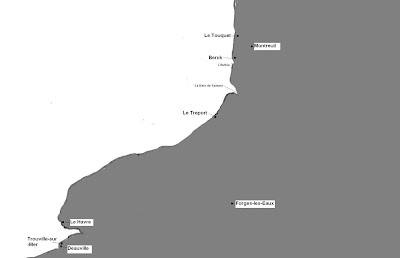These cliffs, known as the Alabaster coast, stretch along the Normandy coast between Le Tréport in the north to Le Havre. If we had to mark the approximate location of Royale on a map, then given the geographic references, we'd have to stick the drawing pin somewhere along Côte Picarde, probably on the south side of the Somme estuary.
 |
| Ian Fleming's northern France (click to enlarge) |
John Griswold has Royale in the same place according to a map in his Annotations and Chronologies for Ian Fleming's Bond Stories (2006), as does David Leigh in an 2004 article exploring James Bond's France. In any case, Fleming confirms that the town is on the stretch of coast south of Le Touquet when he describes Royale in On Her Majesty's Secret Service as “La Reine de la Côte Opale”, the Côte d'Opale being the 120km coastline between the borders of Belgium and Picardy.
What about the inspiration for Royale-les-Eaux? Jon Gilbert in his magnificent Ian Fleming: The Bibliography (2012) states that the town is based on the coastal towns of Deauville, just south of Le Havre, and Le Touquet. However, some of the details of Royale that Fleming provides better fits the description of Trouville, which neighbours Deauville.
As Fleming notes, Trouville, like Royale, was originally a small fishing village and, again like Royale, grew rapidly during the Second French Empire (1852-1870), when the town enjoyed the patronage of artists, the wealthy, and the aristocracy, experienced a degree of urbanisation, and established casinos, hotels, and baths. Trouville's current casino, built in 1912 by Alphonse Durville, perhaps has something of the “Negresco baroque” of Casino Royale about it (presumably Fleming's description refers to Nice's Hotel Negresco); both are decorated with gilt at least.
 |
| Trouville's casino (Photo: Daniel Villafruela) |
One obvious inspiration for this aspect of Royale-les-Eaux is the spa town of Forges-les-Eaux, which is located inland about 30km south of Abbeville. Visitors came to Forges as early as the 17th century to take 'the cure' deriving from the iron-rich springs around the town, but it wasn't until the 19th century that Forges-les-Eaux developed into a resort to rival those on the coast, establishing a spa and a casino. A history that is not so very different from that of Royale-les-Eaux.
Royale-les-Eaux is something of an amalgam of different towns, but the main inspirations appear to have been Trouville and Forges-les-Eaux. This may explain why Royale appears to have been located in Picardy for its first appearance, before being relocated to Pas-de-Calais subsequently. What is clear is that Ian Fleming was very familiar with the places and geography of northern France, and it is no wonder that his writing is infused with the memes of the region.

Je connais très bien cette région pour y avoir grandi et aujourd'hui, je vis à une centaine de kilomètre de là. L'endroit où Ian Fleming situe Royale-les-Eaux change un peu entre Casino Royale et On her Majesty's secret service.
ReplyDeleteLes descriptions qu'il fait de la région sont conformes à la réalité. Par exemple, il évoque les rues pavées de Montreuil-sur-Mer, c'est exact (je suis allé au lycée à Montreuil-sur-mer, je vivais dans une commune à côté).
Ian Fleming connaissait très bien la région, c'est une évidence.
Cordialement,
Sébastien
Merci pour votre commentaire. Il est passionnant de lire sur les endroits que l'on connaît bien dans les livres de James Bond. Je vivais à Maidstone, dans le Kent, et a toujours été très heureux de lire les descriptions de Fleming de la ville dans Moonraker. Ce sont aussi précises que les descriptions de Montreuil -sur-Mer.
DeleteThe stuff in the blogs blows out my mind. https://juegosdecasinoonlinecolombia.com.co
ReplyDelete